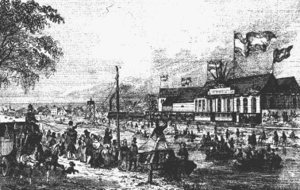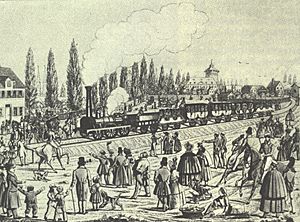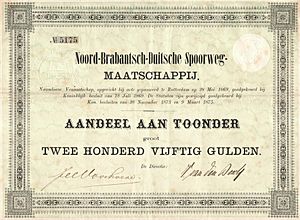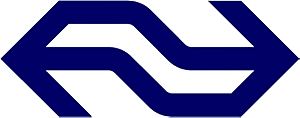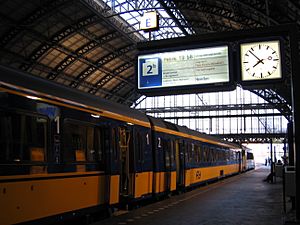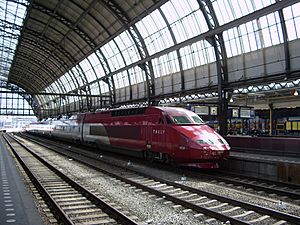History of rail transport in the Netherlands facts for kids
The history of trains in the Netherlands is a long and exciting journey! The very first train ride happened on September 20, 1839. This short trip went from Amsterdam to Haarlem. The train itself was a steam locomotive named the Arend.
Dutch railways have gone through many changes over the years. We can look at their history in different time periods:
- Before 1839: The early ideas and plans for railways.
- 1840-1860: The first railways started to grow.
- 1860-1890: The government helped build more railways.
- 1890-1938: Railways became stronger, forming two big companies.
- 1938-1992: The 'Nederlandse Spoorwegen' (Dutch Railways) was the only train company.
- 1992-present: Other companies joined the train industry.
Contents
The First Train Rides (1839)
How Dutch Railways Began
The first modern railway opened in England in 1830. It connected the cities of Liverpool and Manchester. A Dutch army officer named William A. Bake was there to see it. When he returned to the Netherlands, he had a big idea. He wanted to connect Amsterdam to Amersfoort, and then to Arnhem.
King William I liked Bake's plan. But Bake had trouble finding people to invest money. Business people in the Netherlands were worried about their money at that time. So, Bake's plan did not work out.
Spreading Railway Ideas
Luckily, King William I still wanted to improve railways. He wanted them to be safer and fit the Dutch land. The success of the Liverpool to Manchester railway inspired many. Soon, countries like Belgium and Germany started building their own railways. King William I of the Netherlands did not want to be left behind.
Building in the Netherlands
The King asked engineers to study if a railway system was possible in the Netherlands. Paying for the tracks and trains was a challenge. But on August 8, 1837, the King made a decision. The Dutch government would help pay for this new way of travel.
Two years later, the first railway company was created. It was called the 'Hollandse Ijzeren Spoorweg Maatschappij' (HIJSM). They started building the railway track between Amsterdam and Haarlem. The first steam locomotive to drive on this track was a small train called 'de Arend'.
Growing the Network (1840-1860)
Early Expansion of Railways
The first railway from Amsterdam to Haarlem was a big success. Because of this, railways began to grow across the country. A new railway company was also started. It was called the 'Nederlandse Rhijnspoorweg Maatschappij' (NSR). Both the HIJSM and NSR worked on new railway lines, including one to Rotterdam.
The Route to Rotterdam
The NSR and HIJSM needed to buy land for their new railway. But some landowners and farmers did not like the idea. They worried the trains would scare their cows. There was a famous problem when building the line to Rotterdam. A landowner named Aernout Hendrik van Wickenvoort Crommelin would only sell his land if a train station was built just for him.
The HIJSM and NSR did not like this idea. They tried to build the railway around his land, but it did not work. In the end, Aernout still gave them some land to continue. This problem cost the companies a lot of money. It was later called 'Het laantje van van der Gaag'. The railway to Rotterdam was finished in 1847.
NSR's Own Railway
The NSR also wanted to build its own railway. This line would go from Amsterdam to Utrecht, then to Arnhem, and finally into Germany. Building this line was hard because they could not find enough investors. Luckily, King William I helped again.
There was another problem: Dutch railways used a wider track size (broad gauge). But the connection in Germany used a standard track size. The railway to Utrecht was finished on December 18, 1843. The next part to Arnhem opened on May 16, 1845. The final part to Germany took 11 years. This was because the tracks had to be changed to the standard size.
Government and New Companies (1860-1890)
The 'Spoorwegnet'
In 1860, the 'Spoorwegnet' was created. This was a system of railways built by the government to connect all cities. People in different cities wanted their city to be part of the Spoorwegnet. They knew their city would become more popular if it had a train connection.
More Railway Companies
In 1863, a new railway company was formed to help connect more cities. It was called the 'Maatschappij tot Exploitatie van Staatsspoorwegen'. For short, people often called it the 'SS'. This company was not started by the government. It was a private group of investors. They received a special permit to operate trains on the railways built by the State.
Other companies kept building tracks too. Even more railway companies were started. One was the 'Noord-Brabants-duitse Spoorweg-Maatschappij' (NBDS). It was created to finish a railway line that would connect Saint Petersburg, Berlin, and London.
Merging Companies (1890-1938)
Joining Forces
By 1890, there were many different railway companies. This made train travel confusing for people. Each company had its own rules and trains. To make things easier, all the companies joined together. They then split into two main companies: the HSM and the 'SS'. The railways were reorganized based on English models.
Workers Go on Strike
In 1903, railway workers were unhappy with their jobs. They had to work in bad conditions and were paid very little. In 1903, the workers were so angry that they went on strike. This worked! The company bosses needed the workers, so they improved the working conditions and pay.
When World War I began in 1914, the Netherlands stayed neutral. But trains were partly used to move soldiers and supplies. The war showed how important railways were for transport. Because of the war, the HSM and the 'SS' had to work together. They became closer even after the war. This led to them officially joining together in 1937. This new company was called the 'Nederlandse Spoorwegen' (NS).
Train Stations Over Time
Stations Today
Today, the Netherlands has 404 railway stations. Most of them (381) are managed by the NS. Some stations are very old and beautiful, while others are modern. For example, Amsterdam Centraal Station is a famous old station. A newer one is Utrecht Centraal Station.
Modern stations have many features that make travel easier. You can look up train times online. They also have escalators and elevators, which were not common in the past.
Stations in the Past
In the past, you could only find train times on yellow boards at the station. There was no internet to check. Old stations like Zandvoort show the older style of architecture. Newer stations like Utrecht Centraal Station have a more modern design.
Types of Trains
Trains have changed a lot over time. They started as steam trains, then became diesel trains, and now most are electric trains.
The very first train was 'de Arend', a steam locomotive. It ran from Amsterdam to Haarlem. After that, many different steam trains were made, often named by a series number, like "series 600".
Later, a new type of train was invented that ran on diesel. These trains were cheaper and easier to use. Today, only a few diesel trains are still used in the Netherlands. They are called 'The buffel'. You can find them on lines like Zwolle – Enschede, Zwolle – Kampen, and Apeldoorn – Zutphen.
Most trains today are electric trains. You can spot them by the large electricity masts above the tracks that give them power. Trains usually have two classes for passengers: first class and second class.
In the past, there was also a third class, but it was removed. Almost all trains now offer free Wi-Fi so you can use the internet. Years ago, you had to buy a paper ticket. Nowadays, you can use your OV-chipkaart (a public transport smart card).
Common Train Types in the Netherlands
- Sprinter: These are local trains that make many stops. They are good for shorter journeys.
- Intercity: These are faster trains that connect major cities. They have fewer stops than Sprinters.
- Thalys: This is a super-fast international train. It can reach speeds of up to 300 km/h and connects the Netherlands to other countries like Belgium and France.
Images for kids


